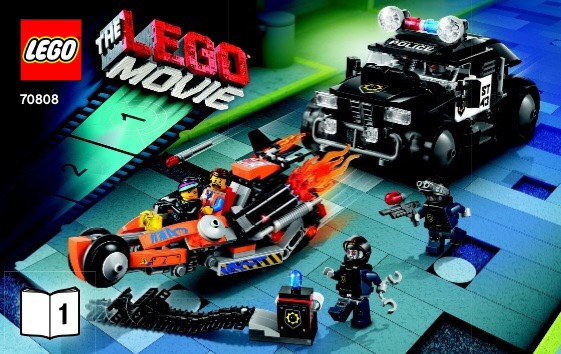
The Super Cycle Chase is my second set within the Lego Movie series.
Key Statistics
Official Page: Lego Store
Brick Instructions: Link
Pieces: 514
Age group: 8-14
Date assembled: 31 January 2015
Assembly duration: 1.5 hours
Main steps: 74
Total steps (includes repetitions & sub-components): 239
Selection & Theme
This Lego set was selected somewhat randomly from the available selection of sets on display at Kmart. All I went by was that it belonged to the Lego Movie theme and looked moderately challenging to build, with multiple units to assemble.
Given this criteria, it also helps to establish the ongoing consideration set for future Lego set selections. Given the precedence of my first Lego set purchase as being part of the Star Wars theme, future selection options will be drawn from these themes.
When I first played with Lego as a kid, the Lego bricks and pieces I had were mainly from today’s Classic and City themes. I also had a limited amount of set/pieces from the Castle theme.
A key attraction for the Super Cycle Chase was that it included three components within.
Characters & Vehicles
Five Lego characters are included in this set – Emmet, Wyldstyle and three Robo SWATs. Wyldstyle operates her two-seater bike, which allows Emmet to accompany her whilst the one Robo SWAT member drives the Robo Police SWAT vehicle with the remaining two in tow.
Wylestyle’s two-seater dragster provides a great orange-based colour contrast to the more conventional black Robo Police SWAT vehicle. Wyldstyle’s Dragster features two seats, a huge rear wheel and translucent exhaust flames. Much of the detail design is achieved via the stickers affixed to the vehicle. The Robo Police SWAT car features a removable roof, gun holder, flip-out flick missiles and opening trunk with dynamite. The Piece of Resistance (glue cap) is included as an accessory, sitting atop the small roll-out spike strip road block. Weapons include 2 blasters, 2 dynamite sticks and handcuffs.
Build
Brick Instructions for this 514-piece set span two booklets and three bags.
The first bag begins with assembly of Wyldstyle, Emmet and a Robo SWAT unit. The first seven steps complete the spike road block accessory with the Piece of Resistance. The spike road block itself is composed of 14 individual pieces. The next 12 steps builds a solid foundation for Wyldstyle’s dragster. The front wheel module is constructed over a 9-step sequence before being connected to the rear foundation. Another 7-step sequence adds the finishing touches on the main body of the dragster. A four-step process defines the rear right structure whilst a six-step procedure creates the rear wheel which attaches to the rear right axle. A final repeat of the same four steps mirror the rear left support. Over four main steps, the finishing touches are added to the dragster. Three steps build the steering wheel component while each translucent exhaust flame is made up of four secondary steps.
The focus of the second booklet is on building the Robo Police SWAT vehicle and the instructions start off with assembling our two Robo SWATs. The first 10 steps build the first layer of the vehicle, and by Step 11 we are adding on the main body of the vehicle. Step 16 sees the vehicle progress further with the wind-shields added on as well as the front and rear bonnets. A total of 18 steps results in the main structure of the Robo Police SWAT assembled. A total of 8 steps creates the front bumper. This also sees the second bag of pieces completely consumed.
The third bag commences with a five-step process to construct the rear hatch, complete with inserting the dynamite into the rear holding area. Another five steps completes the finishing touches for the rear section, followed by another two steps for adding the front section final touches. Seven steps, including affixing the stickers over two steps, completes the rooftop. Each right-side wheel is assembled via a four-step process, complete with the axle rod, with a final three steps each to add the corresponding left wheel/tire onto the final structure. Each side of the vehicle has a section added below the door as a form of step – this module requiring a repeated five steps to be assembled. The final touches are on the side mirrors and loading of the laser guns.
As of this article, I am extending the key statistics section to include the number of main steps as designed in the instruction booklets, and also totalling all sub-component steps to produce a final total amount of steps including all repetitions. The 165 sub-component steps and repetitions increase the number of main steps from 74 by a 223% increase. This is typical of a Lego set, particularly the larger and more complex sets. This modularity in design and assembly is an invaluable lesson for children in helping them to break down complex problems in order to solve them. Typically, having now analysed this Lego set as my third write-up, I have also started to observe some of the key principles behind the Lego design process – they intentionally split up the instructions into modules that tend to have a manageable number of steps to follow. Just reflecting on my commentary above, you will no doubt observe each building block module tends to be about seven steps in length, indicative of how Lego views the ability of a child to handle the sequence of instructions.

2 comments
Comments are closed.